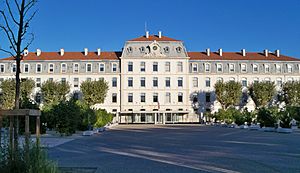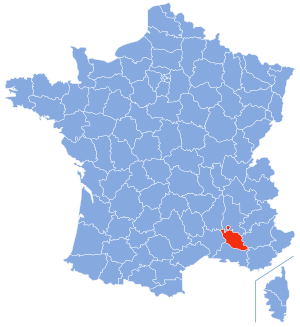Vaucluse facts for kids
Quick facts for kids
Vaucluse
|
|||
|---|---|---|---|

Prefecture building of the Vaucluse department, in Avignon
|
|||
|
|||

Location of Vaucluse in France
|
|||
| Country | France | ||
| Region | Provence-Alpes-Côte d'Azur | ||
| Département | 4 March 1790 | ||
| Prefecture | Avignon | ||
| Subprefectures | Apt, Carpentras | ||
| Area | |||
| • Total | 3,567.3 km2 (1,377.3 sq mi) | ||
| Population
(2014)
|
|||
| • Total | 554,374 | ||
| • Rank | 48th | ||
| • Density | 155.4044/km2 (402.495/sq mi) | ||
| Demonym(s) | Vauclusiens | ||
| Time zone | UTC+1 (CET) | ||
| • Summer (DST) | UTC+2 (CEST) | ||
| ISO 3166 code | FR-84 | ||
| Arrondissements | 3 | ||
| Cantons | 17 | ||
| Communes | 151 | ||
| Website | http://www.vaucluse.fr/ | ||
The Vaucluse (Occitan: Vauclusa) is a department in the southeast of France in the Provence-Alpes-Côte d'Azur region. Its prefecture is Avignon.
It is named after a famous spring, in the commune Fontaine-de-Vaucluse. The name Vaucluse comes from the Latin Vallis Clausa ("closed valley") as the valley here ends in a cliff from which rises a spring.
Contents
History
Vaucluse was not one of the 83 French departments made during the French revolution, on 4 March 1790. It was created on 12 August 1793 with four districts: Apt, Orange, Ouvèze (Carpentras), Vaucluse (Avignon); its capital was Avignon.
In 1800, with the creation of the arrondissements in France, the districts were changed into arrondissements: Avignon, Apt, Carpentras and Orange.
After the Battle of Waterloo (18 June 1815), the department was occupied by the Austrian army from June 1815 to November 1818.
On 10 September 1926, the arrondissement of Orange was eliminated and the subprefecture of Apt was moved to Cavaillon but went back to Apt in 1933.
Geography
Vaucluse is part of the Provence-Alpes-Côte d'Azur region, in southeast France, with an area of 3,567.3 km2 (1,377 sq mi). The department has an exclave to the north, the canton of Valréas, surrounded completely by Drôme department.
The department borders with 3 regions and 6 other departments:
- Occitanie region
- Gard (west)
- Auvergne-Rhône-Alpes region
- Provence-Alpes-Côte d'Azur region
- Alpes-de-Haute-Provence (east)
- Var (southeast) ( a short distance)
- Bouches-du-Rhône (south)
 |
Ardèche | Drôme |  |
|
| Gard | Alpes-de-Haute-Provence | |||
| Bouches-du-Rhône | Var |
The are several chains of mountains in the Vaucluse department, mainly in the eastern half; from northeast to southeast, they are:
- Dentelles de Montmirail, a small chain of small mountains; the highest point is Crête de Saint-Amand, 730 m (2,400 ft) high.
- Vaucluse Mountains (French: Monts de Vaucluse). The highest peak in the Vaucluse department is Signal de Saint-Pierre, 1,256 m (4,121 ft) high.
- Luberon Massif, in the souhteast of the department; the highest point is Mourre Nègre, 1,125 m (3,691 ft) high. The chain is in the Regional Natural Park of Luberon (French: Parc naturel régional du Luberon).
The highest mountain in the department is Mont Ventoux (44°10′26″N 5°16′43″E / 44.17389°N 5.27861°E) that is 1,911 m (6,270 ft) high. It stands alone to the north of the Luberon range, separated by the Vaucluse Mountains, and just to the eastern base of the Dentelles de Montmirail.
There are several valleys and plain in the department. The main important plain is the plain of Comtat where is most of the population of the department. It is to the south and the west of the Mont Ventoux and has the Rhône river to the west, the Durance river to the south and the Vaucluse Mountains to the east.
The main rivers are the Rhône and the Durance, tributary of the Rhône. Other rivers are tributaries of those two rivers.
Climate
The climate in Avignon, at an altitude of 56 m (184 ft), is of the subtype Csa (Mediterranean climate) in the Köppen climate classification.
The average temperature for the year in Avignon is 14.4 °C (57.9 °F). The warmest month, on average, is July with an average temperature of 23.3 °C (73.9 °F). The coolest month on average is January, with an average temperature of 5 °C (41 °F).
The average amount of precipitation for the year in Avignon is 617.2 mm (24.3 in). The month with the most precipitation on average is October with 83.8 mm (3.3 in) of precipitation. The month with the least precipitation on average is January with an average of 22.9 mm (0.9 in).
Administration
Vaucluse is part of the region of Provence-Alpes-Côte d'Azur. The department is managed by the Departamental Council of the Vaucluse in Avignon.
Administrative divisions
There are 3 arrondissements (districts), 17 cantons and 151 communes (municipalities) in Vaucluse.
| INSEE code |
Arrondissement | Capital | Population (2014) |
Area (km²) |
Density (Inh./km²) |
Communes |
|---|---|---|---|---|---|---|
| 841 | Apt | Apt | 128,448 | 1,377.2 | 93.3 | 56 |
| 842 | Avignon | Avignon | 296,303 | 923.7 | 320.8 | 37 |
| 843 | Carpentras | Carpentras | 129,623 | 1,266.4 | 102.4 | 58 |
The following is a list of the 17 cantons of the Vaucluse department (with their INSEE codes), following the French canton reorganisation which came into effect in March 2015:
- Apt (8401)
- Avignon-1 (8402)
- Avignon-2 (8403)
- Avignon-3 (8404)
- Bollène (8405)
- Carpentras (8406)
- Cavaillon (8407)
- Cheval-Blanc (8408)
- L'Isle-sur-la-Sorgue (8409)
- Monteux (8410)
- Orange (8411)
- Pernes-les-Fontaines (8412)
- Pertuis (8413)
- Le Pontet (8414)
- Sorgues (8415)
- Vaison-la-Romaine (8416)
- Valréas (8417)
Demographics
The inhabitants of Vaucluse are known, in French, as Vauclusiens (women: Vauclusiennes).
Vaucluse has a population, in 2014, of 554,374, for a population density of 155.4 inhabitants/km2. The arrondissement of Avignon, with 296,303 inhabitants, is by far the largest. The other two, Carpentras and Apt, have respectively 129,623 and 128,448 inhabitants.
The city with more people living in it is the capital, Avignon (92,209). The subprefectures of Carpentras and Apt have, respectively, 28,447 and 11,885 inhabitants.
Economy
Vaucluse has been always a rural department where farming is the main economic activity. The most important produces in the department are fruits (melons, cherries, strawberrys, apples, grapes and others) and vegetables (tomatoes).
Another important product of the region is wine, mainly those wines known as Côtes-du-Rhône.
Related pages
Images for kids
-
Pont Saint-Bénezet and Palais des Papes in Avignon
-
Gordes, one of the most beautiful villages of France
See also
 In Spanish: Vaucluse para niños
In Spanish: Vaucluse para niños









